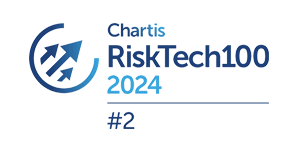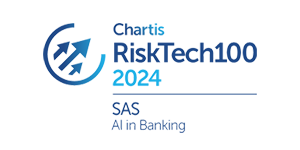

Gestion des risques
Développer ses activités en intégrant une analyse intelligente des risques.
Pourquoi choisir SAS® pour la gestion des risques ?
Rentabilité. Efficacité. Conformité réglementaire.
Quelle que soit la manière dont votre institution financière hiérarchise les risques, SAS dispose de méthodologies éprouvées et des best practices pour vous aider à bâtir une culture consciente des risques, à optimiser le capital et les liquidités et à répondre aux exigences réglementaires. Des analyses de risques performantes, à la demande, entre les mains des professionnels du risque pour garantir l'efficacité opérationnelle et la transparence. Trouver le bon équilibre entre les stratégies à court et long terme. Et répondre en toute confiance aux exigences réglementaires.
RiskTech100® Awards
Chartis désigne SAS comme lauréat dans sept catégories


En poursuivant son ascension dans le classement mondial Top 100 meilleurs fournisseurs de technologies de gestion des risques et de conformité, SAS a remporté sept catégories de prix technologiques, dont l'IA pour la banque, Balance Sheet Risk Management, Behavioral Modeling, Enterprise Stress Testing, IFRS 9, Model Risk Management, and Risk & Finance Integration.

SAS® Risk Management Solutions
SAS dispose de méthodologies éprouvées et de meilleures pratiques pour vous aider à établir une culture consciente du risque, à optimiser la gestion du capital, les liquidités et répondre efficacement aux exigences réglementaires.
TEMOIGNAGE CLIENT
Travailler plus intelligemment avec les solutions de gestion des risques de SAS
Prix Risk.net sur les technologies du risque
SAS remporte quatre prestigieuses récompenses Risk.net
Voir toutes les offres de SAS Risk Management
Gestion de l'actif et du passif (ALM)
Solutions en vedette
- SAS® Asset and Liability Management Flexibly employ cash flow projection and valuation methods with the ability to add sophisticated behavioral models and custom cash flow logic in a cloud-native, modular and transparent solution.
- SAS® Asset and Liability Management Flexibly employ cash flow projection and valuation methods with the ability to add sophisticated behavioral models and custom cash flow logic in a cloud-native, modular and transparent solution.
Des solutions qui étendent les capacités de l'ALM
- SAS® Model Risk ManagementSignificantly reduce your model risk, improve your decision making and financial performance, and meet regulatory demands with comprehensive model risk management.
- SAS® Risk ModelingQuickly develop, validate, deploy and track risk models in house – while minimizing model risk and improving model governance.
- SAS® Solution for Stress TestingRelevez les défis des tests de résistance et de la planification de scénarios stratégiques avec SAS Solution for Stress Testing.
Gestion du risque de crédit
Solutions en vedette
- SAS® Risk EngineMake better, faster decisions based on current views of your overall risk exposure.
- SAS® Credit ScoringDevelop, validate and monitor credit scorecards faster, cheaper and more flexibly than any outsourcing alternative.
- SAS® Solution for Regulatory CapitalProactively manage regulatory risk with a single, end-to-end risk management environment.
- SAS® Risk ModelingQuickly develop, validate, deploy and track risk models in house – while minimizing model risk and improving model governance.
- SAS® Model Implementation Platform Quickly and efficiently execute a wide range of models used in bank stress tests and other enterprise-level risk assessments.
- SAS® Regulatory Content for EBA TaxonomiesMeet European Banking Authority (EBA) reporting requirements and gain business value with a collection of industry-leading reporting content.
Des solutions qui étendent les capacités de gestion du risque de crédit
Stress testing pour votre entreprise
Solutions en vedette
Des solutions qui augmentent les capacités des entreprises en matière de simulation de crise
- SAS® Model Risk ManagementSignificantly reduce your model risk, improve your decision making and financial performance, and meet regulatory demands with comprehensive model risk management.
- SAS® Risk ModelingQuickly develop, validate, deploy and track risk models in house – while minimizing model risk and improving model governance.
- SAS® Solution for CECLQuickly meet new US Financial Accounting Standards Board current expected credit loss (CECL) standards with best practices for modeling, workflow and reporting.
- SAS® Solution for IFRS 9Accelerate time to benefit and quickly meet IFRS 9 standards.
Pertes de crédit attendues (ECL)
Solutions en vedette
Des solutions qui étendent les capacités de l'ECL
- SAS® Model Risk ManagementSignificantly reduce your model risk, improve your decision making and financial performance, and meet regulatory demands with comprehensive model risk management.
- SAS® Risk ModelingQuickly develop, validate, deploy and track risk models in house – while minimizing model risk and improving model governance.
- SAS® Solution for Stress TestingRelevez les défis des tests de résistance et de la planification de scénarios stratégiques avec SAS Solution for Stress Testing.
Gouvernance des risques
Solutions en vedette
- SAS® Governance and Compliance ManagerBuild trust in risk and compliance programs by connecting the enterprise.
- SAS® Model Risk ManagementSignificantly reduce your model risk, improve your decision making and financial performance, and meet regulatory demands with comprehensive model risk management.
Gestion du risque d'assurance
Solutions en vedette
- Enabling Dynamic Pricing With SASActuarial Transformation Through Competitive Tariffs. Optimized Portfolios. Pricing in Real Time.
- SAS for Insurance Contract Valuation | Powered by AzureStay in front of IFRS 17/LDTI compliance requirements without losing visibility.
- SAS® Solution for IFRS 17Simplify your transition to the IFRS accounting standard with best-in-class models, workflow and reporting.
- SAS® Solution for LDTIManage, audit and trace all steps of LDTI compliance processes within a single, integrated environment.
- Solution SAS® pour Solvabilité IISuivez l'évolution des exigences de conformité à la directive Solvabilité II, tout en appréhendantau mieux les risques et la situation financière de votre entreprise.
Des solutions qui étendent les capacités de gestion des risques d'assurance
- SAS® Governance and Compliance ManagerBuild trust in risk and compliance programs by connecting the enterprise.
- SAS® Model Risk ManagementSignificantly reduce your model risk, improve your decision making and financial performance, and meet regulatory demands with comprehensive model risk management.


